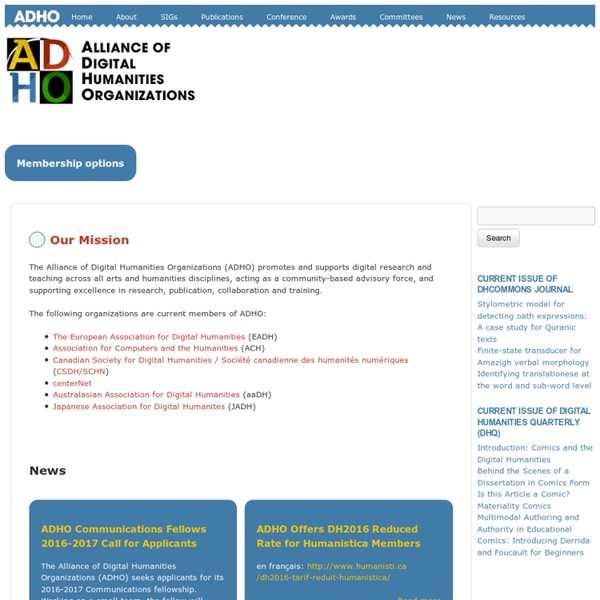



http://adho.org/content/our-mission
Related: Digital Humanities - Humanités NumériquesTools – Carolina Digital Humanities Initiative DH ToolkitsScalarA free, open source authoring and publishing platform that’s designed to make it easy for authors to write long-form, born-digital scholarship online. Scalar enables users to assemble media from multiple sources and juxtapose them with their own writing in a variety of ways, with minimal technical expertise required.OmekaA project of the Roy Rosenzweig Center for History and New Media at George Mason University, Omeka is a free, flexible, and open source web-publishing platform for the display of library, museum, archives, and scholarly collections and exhibitions. Omeka’s Showcase includes projects powered by Omeka. 1 Pings/Trackbacks for "Tools"
Record and share video live from your mobile phone At Skype, we know and love that technology continues to evolve. Today, people carry smartphones around in their pockets instead of being tethered to a desk, allowing people to stay in touch on the go. Skype has likewise evolved to help people stay connected from anywhere on any device, and we’ve continued to see growth on Skype for mobile devices. DHQ: Digital Humanities Quarterly: 2013 Managing 100 Digital Humanities Projects: Digital Scholarship & Archiving in King’s Digital Lab James Smithies, King's College London; Carina Westling, King's College London; Anna-Maria Sichani, King's College London; Pam Mellen, King's College London; Arianna Ciula, King's College London Modelling Medieval Hands: Practical OCR for Caroline Minuscule
TimeMapper Can I make a timemap anonymously? Yes! You do not need an account to create a timemap - they can be created anonymously and will have all the same features and shareability of normal timemaps. Cubelets: Modular Robot Toy-Kit Cubelets is the name of the very first product of “Modular Robotics” – a spin-off from the famous “robot”-Carnegie Mellon University. It is a kit of free combinable, small robot modules. The website goes: By combining sensor, logic and actuator blocks, young kids can create simple reconfigurable robots that exhibit surprisingly complex. This project looks really interesting and the just moved beyond the first beta-testing phase.
Tools Contents Tools for creating, editing, transforming, and publishing TEI documents and schemas are essential to using the TEI Guidelines. Since the TEI rules and recomendations are expressed in XML, TEI users can take advantage of the abundance of XML tools developed for general use. In addition, the TEI community develops and distributes TEI-specific tools. Basics of Mapping for the Digital Humanities – IDRE Sandbox To start, navigate to this page via the URL below: “What is a map? What is in a map? How do you map?” In the Humanities, mapping can be defined in so many different ways, there is no easy answer to these questions. In fact, your research can dictate the parameter of choices that define your map.
Miscellaneous Symbols ? Test for Unicode support in Web browsers Miscellaneous Symbols Characters 9786-9788, 9792, 9794, 9824, 9827, 9829, 9830, 9834 and 9835 are present in Microsoft’s WGL4 character set. Characters 9824, 9827, 9829 and 9830 provide Unicode equivalents for some of the characters in Monotype’s Symbol font. The characters that appear in the first column of the following table depend on the browser that you are using, the fonts installed on your computer, and the browser options you have chosen that determine the fonts used to display particular character sets, encodings or languages.
XTF » Exercise 4: Results ranking Exercise 4: Results ranking Introduction: The preFilters for the various content types extract or produce a minimal set of Dublin Core metadata. This metadata is then further processed by preFilterCommon (1) to create the sort and browse fields in the index. toychest [licensed for non-commercial use only] / FrontPage "Toy Chest" collects online or downloadable software tools and thinking toys that humanities students and others without programming skills (but with basic computer and Internet literacy) can use to create interesting projects. Most of the tools gathered here are free or relatively inexpensive (exceptions: items that are expensive but can be used on a free trial basis). Also on this site are "paradigms"--books, essays, digital projects, etc.--that illustrate the kinds of humanities projects that these thinking tools/toys might help create. A star indicates tools that combine power (advanced, multiple, or flexible features) with ease of use.
Getting started - storify.com Who we are and what we can do for you There is a lot of information streaming through the social web. Tens of thousands of Tweets, Flickr photos, YouTube videos and the like are created every day. There's a lot of good out there, compelling photos and unique voices out there that could be relevant to whatever story you're trying to tell. If you wanted to use something from the social web, you'd have to copy the text, download and re-upload the photo, worry about attribution, etc. Basically, it would be a pain. dhresourcesforprojectbuilding [licensed for non-commercial use only] / Digital Humanities Tools Guides to Digital Humanities | Tutorials | Tools | Examples | Data Collections & Datasets Online or downloadable tools that are free, free to students, or have generous trial periods without tight usage constraints, watermarks, or other spoilers. Bias toward tools that can be run online or installed on a personal computer without needing an institutional server. (Also see Other Tool Lists)